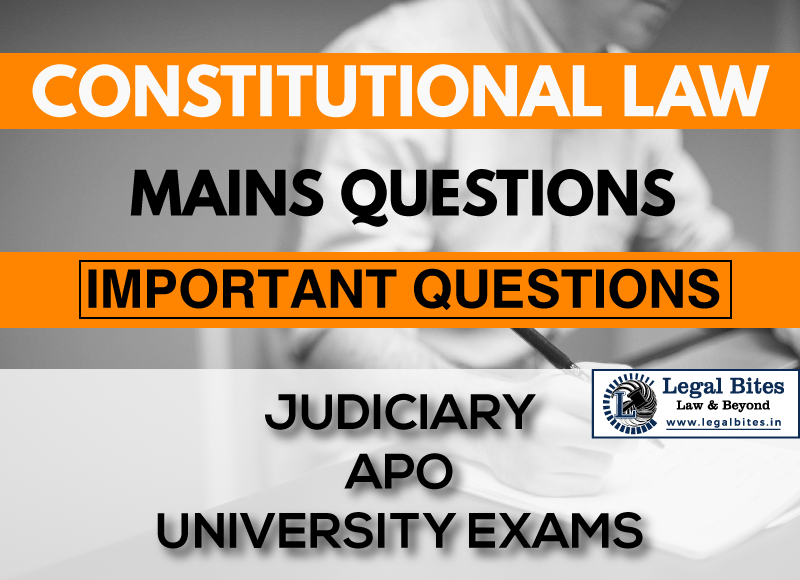What are the procedure and limitations for amendment of the Indian Constitution? Discuss while citing the relevant cases.
Question: What are the procedure and limitations for amendment of the Indian Constitution? Discuss while citing the relevant cases. [RJS 2011] Find the answer to the mains question only on Legal Bites. [What are the procedure and limitations for amendment of the Indian Constitution? Discuss while citing the relevant cases.] Answer The Constitution of India provides for its… Read More »

Question: What are the procedure and limitations for amendment of the Indian Constitution? Discuss while citing the relevant cases. [RJS 2011] Find the answer to the mains question only on Legal Bites. [What are the procedure and limitations for amendment of the Indian Constitution? Discuss while citing the relevant cases.] Answer The Constitution of India provides for its amendment in order to adjust itself to the changing conditions and needs. Article 368 in Part XX of the Constitution...
Question: What are the procedure and limitations for amendment of the Indian Constitution? Discuss while citing the relevant cases. [RJS 2011]
Find the answer to the mains question only on Legal Bites. [What are the procedure and limitations for amendment of the Indian Constitution? Discuss while citing the relevant cases.]
Answer
The Constitution of India provides for its amendment in order to adjust itself to the changing conditions and needs. Article 368 in Part XX of the Constitution deals with the powers of Parliament to amend the Constitution and its procedure.
The procedure for the amendment of the Constitution as laid down under Article 368 is as follows:
- An amendment of the Constitution can be initiated only by the introduction of a bill for the purpose in either House of Parliament and not in the state legislatures.
- The bill can be introduced either by a minister or by a private member and does not require prior permission of the president.
- The bill must be passed in each House by a special majority, that is, a majority of the total membership of the House and a majority of two-thirds of the members of the House present and voting.
- Each House must pass the bill separately. In case of a disagreement between the two Houses, there is no provision for holding a joint sitting of the two Houses for the purpose of deliberation and passage of the bill.
- If the bill seeks to amend the federal provisions of the Constitution, it must also be ratified by the legislatures of half of the states by a simple majority.
- After duly passed by both the Houses of Parliament and ratified by the state legislatures, where necessary, the bill is presented to the President for assent.
- The President must give his assent to the bill. He can neither withhold his assent to the bill nor return the bill to the Parliament for reconsideration.
- After the President’s assent, the bill becomes an Act (i.e., a Constitutional Amendment Act) and the Constitution stands amended in accordance with the terms of the Act.
Though our Constitution grants power of bringing amendment on the Parliament, it is not absolute and the limitation of Parliament’s power of amendment is a basic feature of the constitution. Thus, Parliament cannot enlarge this limited power into absolute power. The procedural limitation on the power of amendment is laid down in Article 368 itself. That the basic feature of the constitution cannot be amended, it is an inherent and implied limitation on Parliament’s power of constitutional amendment.
The concept of the Basic Structure Doctrine was recognized for the first time in the landmark case of Kesavananda Bharati v. State of Kerala [(1973) 4 SCC 22] case, in which the Supreme Court declared that Article 368 did not enable Parliament to alter the basic structure or framework of the Constitution and parliament could not use its amending powers under Article 368 to ‘damage’, ’emasculate’, ‘destroy’, ‘abrogate’, ‘change’ or ‘alter’ the ‘basic structure’ or framework of the constitution.
In Indira Nehru Gandhi v. Raj Narayan [AIR 1975 SC 2299] case, once again the basic structure concept was reaffirmed. The Supreme Court applied the same theory and struck down the 4th clause of Article 329 A on the ground that the Amendment is beyond the power of the parliament and it destroyed the basic structure of the Constitution. The Amendment was made regarding the jurisdiction of all courts including the Supreme Court, regarding the dispute of an election of the Prime Minister of India.
Important Mains Questions Series for Judiciary, APO & University Exams
- Constitutional Law Mains Questions Series Part-I
- Constitutional Law Mains Questions Series Part-I
- Constitutional Law Mains Questions Series Part-II
- Constitutional Law Mains Questions Series Part-IV
- Constitutional Law Mains Questions Series Part-V
- Constitutional Law Mains Questions Series Part-VI
- Constitutional Law Mains Questions Series Part-VII
- Constitutional Law Mains Questions Series Part-VIII
- Constitutional Law Mains Questions Series Part-IX
- Constitutional Law Mains Questions Series Part-X
Admin Legal Bites
Legal Bites Study Materials correspond to what is taught in law schools and what is tested in competitive exams. It pledges to offer a competitive advantage, prepare for tests, and save a lot of money.

